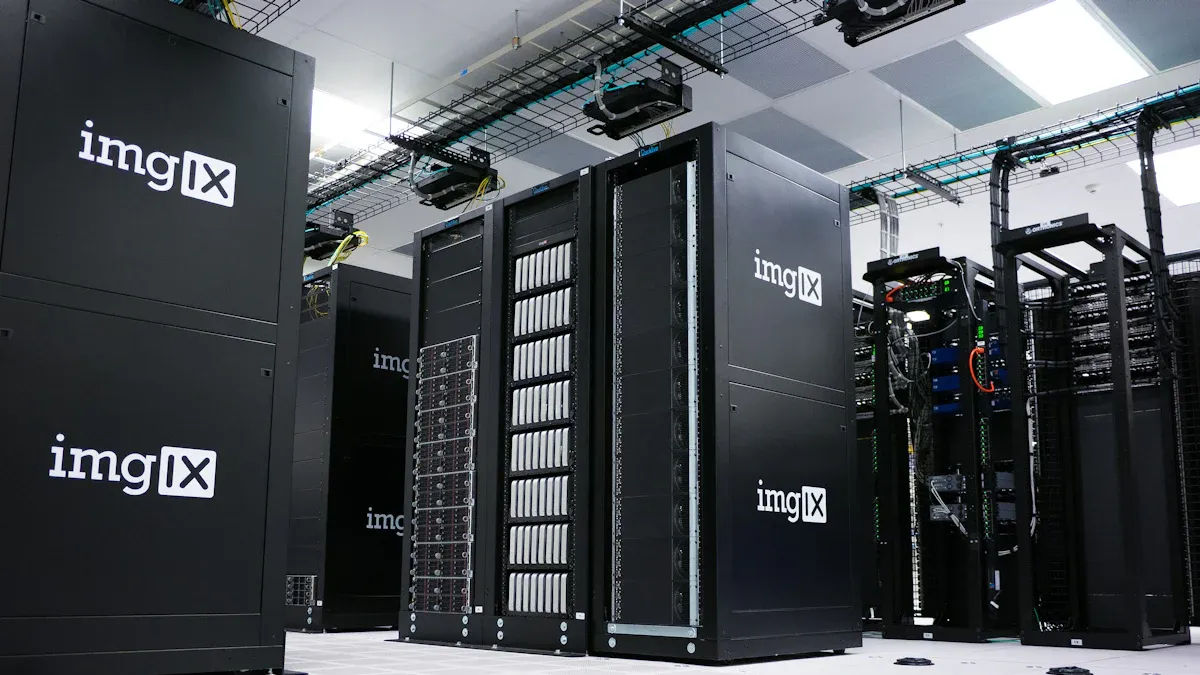SaaS Start-ups: How to Choose Your First Data Warehouse

When SaaS Start-ups choose their first data warehouse, it’s important to have a solid plan. Start by seeking guidance from your leaders. Ensure the data warehouse aligns with the unique needs of SaaS Start-ups. Consider every component, including the warehouse itself, ETL processes, and BI tools. Planning for multi-tenancy is crucial to safeguard customer data, which is especially important for SaaS Start-ups.
Strong support from leadership helps SaaS Start-ups align their data warehouse with their overall business strategy.
This guide provides straightforward steps and tools to help SaaS Start-ups make the right choice.
Key Takeaways
Know what your business needs before picking a data warehouse. Set your goals and know what data you need so everything matches.
Make sure your data warehouse can grow with your business. Pick a system that can handle more data as your business gets bigger.
Think about how much the whole system will cost. Find cheaper options like cloud storage to save money.
Make sure it works well with your current tools. A good data warehouse stops data from getting stuck and helps work go faster.
Plan for multi-tenancy to keep customer data safe. Pick a setup that protects client info and is easy to manage.
SaaS Start-ups: Key Factors
Business Needs
You should start by understanding your business needs. Think about your goals and the data you want to collect. Make a list of what you need from your data warehouse. Here is a simple way to align your choice with your business goals:
Define your business requirements and data needs.
Choose a provider that matches your growth plans.
Plan how you will move your data safely.
Set up ways to bring data from different sources together.
Make sure your data is secure and follows rules.
Keep improving your system after you set it up.
Use features that help your team work together.
Scalability
Scalability means your data warehouse can grow with you. You want a system that handles more data as your business grows. Look at how easy it is to add more space and how much it will cost. Some systems do this automatically, while others need more work. Here is a table that shows what to look for:
Scalability Aspect | Description |
|---|---|
Ease of Scalability | Know your current data and how fast it will grow. |
Ongoing Costs | Pay only for what you use as you expand. |
Staffing Costs | Some systems need more people to manage growth, others do it for you. |
Scalability Paradox | Do not focus so much on scaling that you miss growth chances now. |
Cost
You need to think about cost before you choose a data warehouse. Prices can range from $200 to $2 million. The average yearly cost for cloud storage is about $359,951. Costs depend on how complex your data is and how big your company is. Many SaaS Start-ups save money by using modern storage like S3 and serverless engines. These options can cut costs by up to 90%. Here are some ways to save:
Use object storage with open formats.
Pick solutions with per-second billing to avoid paying for idle time.
Integration
Integration helps you connect your data warehouse to other tools. You may face problems like data silos, high costs, and trouble with old systems. You want a warehouse that works well with your current tools and keeps your data safe. Here is a table of important features:
Criteria | Description |
|---|---|
Scalability | Handles more data without slowing down. |
Flexibility | Works with many systems and databases. |
Compatibility | Supports different connectors. |
Data Governance | Keeps data safe and follows rules. |
Security | Protects data during moves and storage. |
Ease of Use | Simple for everyone to use. |
Ongoing Support | Help is available when you need it. |
Poor quality or inconsistent data can easily cause problems and make your workflows less efficient.
Support
Support is important when you run into problems or have questions. Look for providers that offer help through chat, email, or phone. Good support helps you fix issues fast and keeps your data warehouse running smoothly.
Why Data Warehousing Matters

Centralized Analytics
You need one place for all your data. A data warehouse brings data from many places together. This helps your team find answers fast. It also helps everyone share ideas easily. Centralized analytics give you some big benefits:
Consistency: You change data from different places into one format. This makes it easy to compare numbers and understand them.
Centrality: Your team finds what they need in one spot. You save time because you do not search in many systems.
Unified Business Intelligence: You see all your data at once. This helps you make better choices for your company.
Centralized analytics stop confusion and help you work faster.
Data-Driven Growth
You want your business to get bigger. A data warehouse gives you tools for more complex data. This helps when you add new products or services. You can use automated solutions to connect data from apps, websites, and other places. This helps you spot patterns and make smart choices. Here is a table that shows how a data warehouse helps you grow:
Key Factor | Description |
|---|---|
Data Complexity | You handle more types of data as you grow. |
Automated Integration | You connect many sources without extra work. |
Actionable Insights | You find answers fast and stay ahead of others. |
Many clients want to use outside tools to manage data. If you load customer data into your warehouse, you can raise contract value by up to 20%. Big clients often ask for this feature.
Multi-Tenancy
If you have many customers, you must keep their data safe and separate. Multi-tenancy means you store data for different clients in one system. You can pick different ways to do this. Each way has good and bad sides. Here is a table that explains your choices:
Approach | Pros | Cons |
|---|---|---|
Shared Database with Tenant IDs | Lowest cost, easy to manage, quick setup, scalable | Weaker isolation, noisy neighbor issues, hard queries |
Schema per Tenant | Better isolation, easy backup, more customization | Harder to manage, resource limits, less scalable |
Database per Tenant | Maximum security, no noisy neighbors, full customization | Highest cost, complex setup, slower onboarding |
Executive support helps you pick the best way for your SaaS Start-ups and keeps your data warehouse working well with your business goals.
Selection Steps

Define Requirements
Start by figuring out what you want your data warehouse to do. You need to know your business goals and what your users expect. Talk to people from finance, marketing, and operations. Each group has different needs and ideas. Make sure you look at your current technology and where your data comes from. Write down what you want your data warehouse to handle.
Here is a simple way to define your requirements:
Set your goals. Decide what you want to achieve and what your users need.
Review your current systems. Check where your data lives and how you use it now.
List the features you want. Think about security, speed, and how you will use the data.
Choose your platform. Decide if you want cloud or on-premises. Pick based on your data sources and security needs.
Make a plan. Set your budget and timeline. Think about risks and how to handle them.
Design your system. Plan how your data will move and how you will keep it clean and safe.
Build and test. Set up your platform and make sure it works.
Train your team. Teach everyone how to use the new system.
Support and improve. Keep checking how things work and make changes as needed.
Involving different teams early helps you build a data warehouse that fits your whole company.
Evaluate Options
Now you need to look at different data warehouse choices. Make a list of what matters most to you. Some things to think about:
How fast can you get value from the system?
Does it need a lot of work to keep running?
Is the cost easy to understand and does it fit your budget?
Will your developers find it easy to use?
Does it work well with your other tools?
You should also look at:
Deployment: Is it in the cloud, on-premises, or serverless?
Data Loading: How easy is it to bring in your data?
Querying: Can you get answers quickly?
Scaling: Will it keep up as your data grows?
Pricing: Are there any hidden costs?
Most SaaS Start-ups pick three to five vendors to look at closely. Try out demos, ask for feedback, and talk to your team before you decide.
Compare Technologies
You will see many data warehouse options. Some popular ones are Snowflake, Databricks, and DuckDB. Each has strengths and weaknesses. Here is a table to help you compare:
Feature/Capability | Databricks | Snowflake |
|---|---|---|
Core Focus | Data engineering, machine learning | Business intelligence, data storage, querying |
Architecture | Built on Apache Spark, real-time analytics | Cloud-native, centralized |
Data Processing Speed | Very fast, up to 12X faster than some others | Good for storage and querying, not as fast |
Interoperability | Works with many engines | Needs third-party tools for some tasks |
Vendor Lock-in | Less vendor lock-in, open-source options | More vendor lock-in, but improving |
Recent Developments | Added new cloud warehousing features | Adding more data engineering features |
You should also think about cloud versus on-premises solutions. Here is a quick comparison:
Feature | Cloud Data Warehouse | On-Premises Data Warehouse |
|---|---|---|
Infrastructure | Uses cloud storage and computing | Uses your own hardware |
Scalability | Easy to scale up or down | Needs more hardware to grow |
Investment | Pay-as-you-go, flexible | Big upfront cost |
Maintenance | Handled by provider | Needs your IT team |
Compliance | Provider helps with certifications | You handle all compliance |
Disaster Recovery | Built-in by provider | You must plan for it |
Cloud options work well if you want to grow fast, save money, and let your team focus on other jobs.
Plan Implementation
Planning your data warehouse setup is key. Start by setting clear goals and getting your teams involved early. Make a plan for who owns the data and how you will keep it safe. Use a data catalog to track what you have.
Build a system that can grow with you.
Automate how you move and clean your data.
Protect your data with strong security and access controls.
Train your team to use new tools and dashboards.
Keep improving your system by listening to feedback.
Watch out for common problems. If you do not have a clear plan, your data can get messy and hard to use. Make sure you have enough people to help with the setup. Plan for emergencies, like system outages, so you can fix problems fast.
A good plan helps you avoid delays and keeps your data warehouse running smoothly.
Plan for Growth
Think about the future when you choose your data warehouse. You want a system that can handle more data and new types of analysis as your business grows. Set up one place for all your data so you always have clean and useful information.
Use tools that let you see trends and predict what will happen next. Real-time analytics help you spot problems, like customers leaving, before they get big. Track important numbers, like monthly and yearly revenue, to see how your business is doing. Watch for changes in customer sign-ups and usage so you know when to scale up.
Keep an eye on how fast your system responds, how much memory and processing it uses, and how many errors you see. This helps you know when it is time to make changes or add more resources.
Planning for growth means you can keep up with your customers and stay ahead of the competition.
Decision Tools
Checklist
You need a clear checklist when you choose your first data warehouse. This helps you stay organized and focused. Use this list to guide your process:
Align your department goals with the main project.
Decide how big your project will be and which business processes it will touch.
Look at your current tech stack and think about what you will need in the future.
Make a disaster recovery plan to protect your data if something goes wrong.
Check every layer of security, including how you will spot and stop threats.
Plan for compliance and find ways to lower regulatory risks.
Tip: Review this checklist with your team before you make any final decisions. This helps you catch any missing steps and keeps everyone on the same page.
Matrix
A decision matrix helps you compare your options side by side. You can use it to see which data warehouse fits your needs best. Follow these steps to build your own matrix:
Step | Description |
|---|---|
1. Identify your alternatives | List the data warehouse options you want to compare. |
2. Identify important considerations | Choose the criteria that matter most to your business. |
3. Create your decision matrix | Set up a table to match each option with each criterion. |
4. Fill in your decision matrix | Score each option based on how well it meets each criterion. Use a simple scale, like 1 to 5. |
5. Add weight | Give more points to the criteria that matter most to you. This helps you see which option stands out. |
You can use this matrix to make your choice easier. It gives you a clear view of your options and helps you make a smart, data-driven decision.
Using a checklist and a decision matrix together makes your selection process stronger and more reliable.
You now have a clear path to choose your first data warehouse. Start by defining your needs, then compare your options using the checklist and decision matrix. Strong executive support helps you stay on track. Build a data stack that grows with your business. Plan for the future from the start. If you need more help, review a buyer’s guide or talk to experts. 🗂️
FAQ
What is a data warehouse?
A data warehouse stores your business data in one place. You use it to organize, analyze, and report information. It helps you make better decisions by showing clear patterns and trends.
How do you know if your SaaS start-up needs a data warehouse?
You need a data warehouse when your data comes from many sources. If you want to track growth, spot trends, or share reports with your team, a data warehouse helps you do this easily.
What is multi-tenancy in a data warehouse?
Multi-tenancy means you keep each customer’s data separate in one system. You protect privacy and security for every client. You choose the best setup based on your business needs.
How much does a data warehouse cost for SaaS start-ups?
Costs change based on size and features. You might pay as little as $200 or as much as $2 million. Cloud options often save money because you pay only for what you use.
What tools work with a data warehouse?
You connect ETL tools to move data, and BI tools to create reports. Popular choices include Fivetran, dbt, and Tableau. These tools help you clean, organize, and understand your data.
See Also
Navigating Challenges in Modern Data Management for Businesses
Creating a Cohesive Data Mart for S&OP Strategies
Real-World Examples of Effective Big Data Architectures

